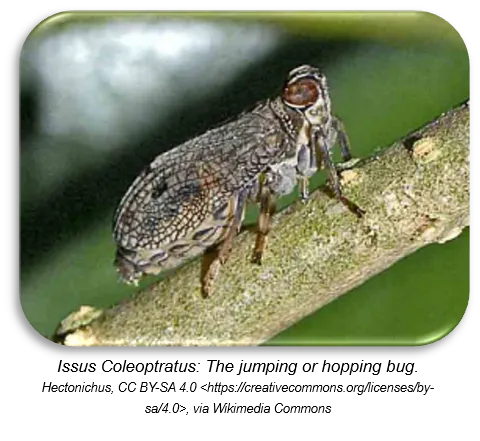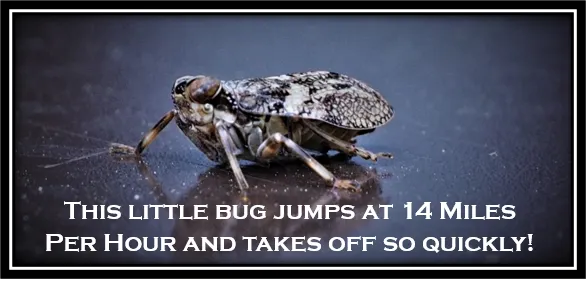Gears On Purpose
Jumping Bug.
 A long time ago, clocks were invented that could accurately tell time. As we all know the very first clock was a sundial!
A long time ago, clocks were invented that could accurately tell time. As we all know the very first clock was a sundial!
Subscribe!
5.99 mo. To watch videos!
Unlock all features!
We have sent you an email with instructions to reset your password.
You have successfully changed your password. You can now log in.
New accounts are reviewed by the administrator. We will send you an email once your account is approved.
Recently, a surprising discovery was made when looking at a baby bug through a microscope! (You never know what you might find using one of these.) You see all sorts of neat details that we cannot detect with the naked eye!
A couple of biologists: Malcolm Burrows and Gregory Sutton, from the University of Cambridge in the U.K., were very surprised to find that these plant hoppers called Issus Coleoptratus have an intricate gearing system that locks their back legs together when they are baby Nymphs; this is so both legs rotate and act at the same time so it can jump forward with great speed! As of late, no one has discovered anything else in nature that has gears like this!
Watch closely as this little bug moves in slow motion. You can see the gears moving in this video from Cambridge University as they show us how this little bug jumps at 14 Miles Per Hour and takes of so quickly!
Who would be looking for gears in nature if they believed that there was no special Creator or Designer that would think of making gears?
If the little bug did not jump the same on each little leg, it would throw it off to one side or another and its speed would easily kill it.
These little gears really do look manmade, don't they?
These gears were designed very special with curved grooves so that they do not wear down the gears as they scrape together.
Researcher Gregory Sutton said that the insect evolved the gears. But we know that these gears did not evolve by accident. It was not an oops. Everything -even little bugs- were made special by God! We know the bug did not come from chance because of two things:
 It's crazy that we can take a little lesson about a baby bug with gears on its back legs and saliva that can eliminate poison in what it eats, and turn it into a Bible lesson isn't it? It's not the first time that we look at nature and learn a lesson!
It's crazy that we can take a little lesson about a baby bug with gears on its back legs and saliva that can eliminate poison in what it eats, and turn it into a Bible lesson isn't it? It's not the first time that we look at nature and learn a lesson!
Proverbs chapter six tells us to consider an ant to learn a lesson about being lazy and not wanting to work to do what we need to in life!
Jesus talks about us considering the lilies of the field, grass, and birds to show us that he cares for each detail of our lives.
Isn't it something that when we go about our day, we make the same mistakes as modern scientists who don't believe in God? How do we do that? We are not thankful or thoughtful of our Creator and Lord while we take so many tiny things for granted that we cannot see with the naked eye! Like God's Love, and his promises to take care of us
Sometimes we get so worried about not having enough money, where to buy our clothes, where we will get our food, how we are going to go somewhere, etc. little realizing God already has all of that under control!
That's also another lesson that we can learn from this little insect!
He eats poisonous leaves. (That's what he was designed by the Creator to do) But he doesn't let the poison stay.
Sometimes we have thoughts that we do not like come into our heads. When we dwell on these bad thoughts it is like the poison in the ivy leaves. We get challenges in our minds that pop up! It happens all the time! But what is so very important is that just like the plant hopper dissolves the bad stuff and eats up the good, we need to dwell on the good thoughts of our mind and choose not to think and dwell on the bad thoughts! That's what helps us to be thankful and to consider all the little things God does for us!
Truly, our Creator thinks of everything! Including us!
REFERENCES:
• Special Gears: Inspired Evidence Bruce Malone with Search for The Truth Ministries
• https://www.smithsonianmag.com/science-nature/this-insect-has-the-only-mechanical-gears-ever-found-in-nature-6480908/#:~:text=Malcolm%20Burrows%20and%20Gregory%20Sutton,the%20tiny%20creatures%20jump%20forward.
• What it eats: https://bio.biologists.org/content/5/3/252#:~:text=Issus%20coleoptratus%20is%20a%20small,the%20phloem%20sap%20from%20ivy.&text=coleoptratus%20can%20cope%20with%20the,saponins%20in%20its%20body%2C%20I.










